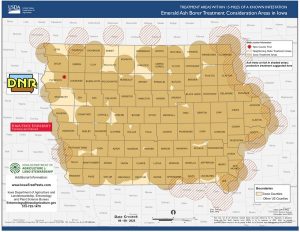CLICK HERE for the latest market quotes from the Iowa Agribusiness Network!
CLICK HERE for the latest market quotes from the Brownfield Ag News Network!
CLICK HERE for the latest market quotes from the Iowa Agribusiness Network!
CLICK HERE for the latest market quotes from the Brownfield Ag News Network!
(Radio Iowa) – The University of Iowa is expanding its wilderness education program to reach 45-hundred elementary school children this year, and it should bring the outdoor learning experience to more than six-thousand next year. Jay Gorsh, director of U-I School of the Wild, says the program is typically a five-day field trip that takes fourth, fifth and sixth graders out of the classroom and into the woods. Gorsh says it helps kids to develop a sense of awareness and appreciation for nature. “Most often we use the three habitats in Iowa: prairie, wetlands and woodlands,” Gorsh says. “Then regularly we have a day of outdoor skills. Sometimes there’s an Archaeology Day in there. Sometimes you might have an entire day dedicated to wildlife or a specific type of wildlife. Here in Iowa City, we have an entire day dedicated to birds, so we have an Ornithology Day.”
Part of the thrill, he says, is getting kids to try things they’ve never had the opportunity to do before, like kayaking, or having what he calls a wildlife experience. “We can use some long-handled nets along the shore of a lake or in a creek and catch some frogs or tadpoles, and they can hold those frogs and tadpoles in their hand and be able to study them,” Gorsh says. “From there we can get into some biology by having them try to determine what specific type of frog is that that they’re holding. Is it male? Is it female? How do we know?” Kids today are being increasingly pushed indoors, he says, and too many of them know too little about the natural, wonderful world around us.
“What we would like to do is kind of disconnect, unplug the kids, get them out into nature, get them away from their electronics a little bit,” Gorsh says. “Also, there’s just a lot to be said about spending a day in the woods as far as how it makes you feel. For most people, that’s a pretty relaxing experience.” The U-I’s Wildlife Camps program started in 1991 and over time, morphed into becoming the School of the Wild. For many years, it was limited to the Iowa City-Cedar Rapids area, but just before the pandemic, they experimented with taking the program on the road so students elsewhere in Iowa could learn about nature in their own areas.
“It went really well. The feedback was very positive from families, from kids, from teachers, so we decided to go ahead and launch this thing across the state and see if it took off,” Gorsh says. “So now, there are programs that are running in county, state, even federal parks all across the state at different times in the year.” The School of the Wild is working with 83 schools in 50 Iowa districts in 36 counties this year, and Gorsh says it’s been expanding by about 15-hundred students every year.
Chris Parks speaks with Cass/Adair County Conservation Officer Grant Gelly and Officer Austin Durnin about all things outdoors. This week they talk about fishing opportunities, water recreation tips, young wildlife and much more.
Podcast: Play in new window | Download (29.8MB)
Subscribe: RSS
(Radio Iowa) – Iowa is back in the “Drought Watch” category on the system put together last year to keep tabs on the situation. D-N-R Hydrology coordinator, Tim Hall, works with other state agencies in assessing the issue. “We take a number of factors and look at them together. And we we decide whether a region of the state is normal, drought watch, drought warning, or drought emergency,” Hall says. He says the drought watch is similar to a thunderstorm or tornado watch.
“Which is really just a call for people to be very careful and pay attention. Because things are looking on the dry side,” he says, “and right now they’re getting a little bit worse all the time. So we’re just trying to keep an eye out and work with folks to make sure everybody has the information they need.” Hall says the state is also seeing the start of what could be a “flash drought,” or rapid increase in drought conditions in some areas. “Particularly in the eastern part of the state where things just got really dry really fast. We saw the U-S Drought Monitor pop up with severe drought in in parts of northeast Iowa and southeast Iowa. So you know, we were kind of on the mend there for a while and then March and particularly April and May have just turned dry on us and they have not done us any favors,” Hall says.
He says there are some indications the conditions might change and bring more rain, and June is normally the wettest month in the state. Hall says until we see more rain, everyone should do what they can to stop water waste by fixing any leaky fixtures. “Which is which is about as pure and simple wasting water as you can get. If you’re just dribbling it down the drain, you’re using resources to pump the water, to treat the water to get it to your house. And if you’re just letting it go down the drain, that’s an absolute waste of resources,” Hall says. “So figure out how to get those leaking faucets fixed and leaking toilets fixed.”
Hall says the situation may soon call for other measures as well. “Unfortunately, it looks like we’re getting into a situation where we’re going to have to start to remind people that water conservation is a necessary thing,” he says. “And we’re going to have to try to work on that a little bit in the state as we get through these dry, these dry weeks here.”
Hall says the best case scenario would be for normal June rainfall to return and turn the drought conditions around. But he says we have to be prepared if that does not happen.
(Ames, Iowa) – June is here, and summer is well underway! Iowa’s future beef farmers are getting their beef projects ready for the county fair, kids are hanging out at the pool, and the smell of beef on the grill wafts through the air. As a parent trying to survive summer vacation, you may be looking for new and exciting things to keep your child entertained. Look no further and break out the crayons and colored pencils because the Iowa Beef Industry Council is having a coloring contest!
Participation is hassle-free. Download the coloring page found on the IBC website and let the creativity flow. After your child has colored the beef grilling sheet to the best of their ability, upload a high-quality photo of their work in the form provided. Participants will be divided into four categories: 2-3, 4-5, 6-7, and 8-9 years of age. The winning picture from each category will receive a $25 beef certificate and an age-appropriate summer grilling swag item.
(Radio Iowa) – There are now just two Iowa counties without an emerald ash borer infestation. The Iowa Department of Agriculture says the wood-boring beetle has been confirmed for the first time in Plymouth County after a tree service found evidence of the bug in an ash tree in Remsen. Plymouth is the 97th Iowa County to have a confirmed infestation, and that leaves just Emmet and Palo Alto County without the invasive beetle. E-A-B was first discovered in Iowa in Allamakee County in 2010. 
The Ag Department says trees typically die within two to four years after becoming infested.
(Iowa DNR News) – If you are ready to explore Iowa’s happy trails and hidden gems, you should download the State Park Passport for a chance to win prizes as you visit parks and forests across Iowa! It’s free to sign up — the more parks you visit, the more chances for prizes! Please note: If you signed up in 2022, last year’s passport has expired. You must sign up again for the 2023 State Park Passport to participate.
From now through Oct. 31, State Park Passport holders can earn points by checking into more than 60 state parks and forests. Get started by signing up and downloading the passport onto your mobile device. Along with checking into parks through the passport, visitors can then discover “Hidden Gems” as they explore. Each park and forest on the passport includes a description of a “Hidden Gem” feature, such as a historical marker, scenic overlook, special trail and more.
New this year — earn and “bank” points that can be redeemed for various prizes. Each park has a different point value (either 100, 200 or 300 points), with remote parks earning higher points. Additionally, every 300 points earns a chance at a sweepstakes prize package.
Prizes for the 2023 State Park Passport:
500 points – any passholder redeeming at this level gets $5 off an overnight camping stay
1,000 points – first 500 passholders to redeem at this level get a weather-proof sticker
2,500 points – first 300 passholders to redeem at this level get a ceramic coffee mug!
Once points are redeemed, your passholder points reset to zero. So, cash-in early, or bank points for higher level prizes. Additionally, for every 300 points earned, passholders are automatically entered into a drawing to win a paddling package (kayak, paddle, life jacket and dry bag) or a three-night stay at a cabin at Lake Darling State Park. There is no limit to the number of entries!
Prizes were donated by sponsorship partners Bass Pro Shops and the Iowa Hunter Education Association. 
Post a selfie at the hidden gem with the hashtag #IowaStateParks on Facebook, Instagram or Twitter and the DNR will randomly select one photo to win an outdoor cooking package!
DES MOINES— Iowa DNR officials are asking for the public’s help in determining the cause of a fish kill yesterday (Thursday), along Squaw Creek in the Franklin County town of Hampton.
Thursday afternoon, a local angler reported dead fish in Squaw Creek in East Park in Hampton. The DNR investigated and found that the fish kill extended approximately 1.5 miles upstream through the town of Hampton.
No definitive source of the kill has been identified at this time, though the DNR is continuing to investigate. Any information or tips from the public with knowledge of a possible cause are requested to contact the DNR’s environmental field office in Mason City at 641-424-4073